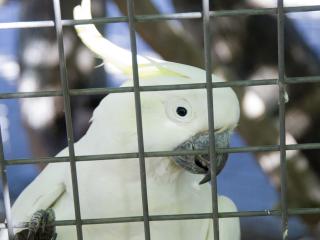Pests in aviaries
In WA home gardens, aviaries are affected by rodents, insects and feral birds, which can spread parasites and bacterial and fungal diseases.
Mice and rats are attracted to bird food and can contaminate food containers with their excretions. Exclude rodents from the aviaries by surrounding the base of the aviary with a galvanized iron sheet. This should be 300mm above ground and dug in 300–600mm. A concrete floor will prevent the rodents digging into the aviary. If any rodent manages to get in they can be controlled using traps situated in bird proof boxes within the cages. To avoid rodents keep the outside of the aviaries clean of food scraps. Hanging feed dispensers rather than floor or wall mounted will help to discourage rodents. Install traps and poison in bird proof boxes outside the aviary. Some aviary owners keep a resident guinea pig in the aviary to deter rats and mice.
Insects can also be transmitters of diseases and parasites. In WA ants and cockroaches are the most common insect pests in aviaries, apart from mites, ticks and fleas. If required, an application of a registered surface spray should control most insects (consult with your chemical retailer, hardware or pet shop).
It is also important to avoid aviary birds being in contact with wild birds. Double wire on the outside will make predation by wild birds more difficult as some can attack through single wire. Wild birds are often transmitters of internal parasites (for example, intestinal worms) or air sac mites, Sternostoma tracheacolum.
The popular gouldian finches and canaries are particularly susceptible to air sac mites. A clinical sign of air sac mites is open mouth breathing, which has a characteristic clicking sound. In a heavy infection some birds can be observed gasping for air. Other signs include coughing, nasal discharge, tail bobbing, weakness and weight loss. If your birds are affected, consult your local veterinary for treatment.
Unfamiliar pests
The Department of Agriculture and Food, Western Australia (DAFWA) is on the lookout for animal and plant pests, diseases and weeds that could pose a threat to agriculture and the environment.
If you discover something unfamiliar, please send a photo to the Pest and Disease Information Service (PaDIS) by email: info@agric.wa.gov.au or phone them on Freecall: 1800 084 881.
Please read the sending specimens for identification web article before sending, or bringing in, samples to the Pest and Disease Information Service, 3 Baron-Hay Court, South Perth, 6151, WA.

